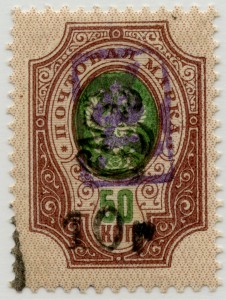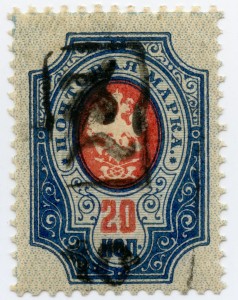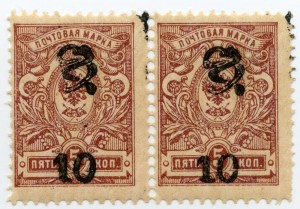For those who are interested, there is much more to discover than what the catalogs suggest. This is especially true for the 10 ruble HH overprint. Not only is there a second type – which is described by Tchilinghirian and Ceresas, but not listed in the catalogs – but also several specialties like two stages overprints exist.
The 10 ruble HH overprint Type 1
The foot of the “1” is tilted (goes down at the right side), the base of the “r” is lower that the “0”. The endpoints of the H are sharp.
The 10 ruble Type 1 overprint on “fresh” stamps
Most know the “common” 10 ruble overprint which was used primarily on the 25, 35 and 70 kopek perforated stamps.
10 ruble HH overprint Type 1 on 25 kopek perforated stamp.
10 ruble HH overprint Type 1 on 35 kopek perforated stamp. This strongly inked overprint shows the borders of the used cancel.
10 ruble HH overprint Type 1 on 50 kopek perforated stamp.
The 10 ruble Type 1 overprint on already overprinted stamps
Later, due to the increased need of 10 ruble stamps, different basic stamps (rare!) and stamps with existing HP overprint (framed and unframed Z) were used.
10 ruble HH overprint Type 1 over an unframed lilac Z.
10 ruble HH overprint Type 1 over a framed lilac Z.
10 ruble HH overprint Type 1 over unframed Z.
10 ruble HH overprint Type 1 over framed Z.
10 ruble HH overprint Type 1 over framed Z.
The 10 ruble HH overprint Type 2
Not so well known is the second type of the 10 ruble HH overprint. This scarcer overprint type was discovered and described years after its use. The stamp was supposedly produced to meet the sudden need of much more 10 rubles stamps when inflation, due to war with Turkey (they were aggressively invading) and Bolshevist activities, rised much faster than in the neighboring countries Gerogia and Azerbaidhan. The inland letter rate increased from 5 to 10 rubles.
The left side of the foot of the “1” is missing its end and there is a distinctive gap in the right side of the “0” that is present on all imprints – sometimes not so easy to spot when overinked. The gap developed probably because of a bubble of air during casting time. Its existence helps a lot separating this overprint from Type 1 overprints were the “r” did not print or is very weak due to tilting the cancel or weak inking.
Good news: Forgeries of this type are very rare – to this day, since this type was unknown for years and the early forgers missed it thus.
The 10 ruble Type 2 overprint on “fresh” stamps
Ceresa lists a pure “10” only overprint on 10 ruble stamps. I have so far not seen this stamp or even a picture of one. Which does not necessarily means that it doesn’t exist.
The 10 ruble Type 2 overprint on already overprinted stamps
Like with the Type 1 overprint existing stamps with HP (framed or unframed Z) were additionally overprinted with the new value. One could guess that this was, what they had in mind when producing a “value only” cancel.
The 10 ruble Type 2 combined two stages overprint on fresh stamps
The two stages overprint! This is the real reason for this post. One unlucky clerk got a quite intricate task. A fresh stamp got a monogram from one of the existing cancels, but the value was not allowed to print. He had to tilt the cancel or use extra paper to prevent the numerals from printing. For reasons unknown today they refrained from damaging the existing stamps. After this the 1o rubles Type 2 overprint was applied. This way overprints were created, that show the upper part (monogram) of another ruble type (for instance the smaller type of the 5 ruble cancels) while at the bottom a 10 was displayed.
As you can see, we have quite clear impressions which show how accurately this was executed. Also new ink in good quality was used.
The 10 rubles Type 2 overprint together with the upper part of a 5 rubles Type 3 overprint.
The 10 rubles Type 2 overprint together with the upper part of a 5 rubles Type 1 or 2 overprint.
For further study I suggest reading the books form Tchilinghirian and Ceresa.














It’s good to have such excellent illustrations on line! It’s the first time many Armenia collectors have the possibility to see what the overprints SHOULD look like …
There is only one problem: the “10r” Type 1 overprint can look very different according to the type of ink used. Please show this!
Good Luck in 2011!
TP
Several of the 10R HH surcharges illustrated above are clever and not so clever forgeries which will be described in a forthcoming HH Forgery Guide
Its a pity with all his expertise and knowledge on the subject that Dr. Ceresa will not share his doubts with us on the above subject freely within the site with fellow enthusiasts. Instead we will have to purchase his book to find out.
Came across this post, very interesting especially the part regarding the Type 2 10R overprint.
I found a stamp in my collection that seems to match the characteristics of this overprint. Furthermore I see your comment “Ceresa lists a pure “10″ only overprint on 10 ruble stamps. I have so far not seen this stamp or even a picture of one.”
Please take a look at my link, is this the stamp being addressed by the comment?
Thanks!